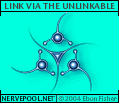L. Dunn, 1993
L. Dunn, 1993
_____________ Like, Hyper Meme Glossary
___________
Ebon Fisher
Compiled for the Exhibit, MEME BREEDERS,
Akus Gallery, E. Connecticut State University, October 1996
Ambiguity
This is not a formal memetic term, but it is of the obvious nature of things. There is a paradox to meme theory in that it feigns objectivity over a subjective domain. Given that we are mentally swimming amongst the entities in question, we are playing a game of hunches here. It's as if the neurons that make up our own brains were grasping at the phantoms which they collectively produce. This author suggests that you take memetic theory, post-modern theory, and any and all theories, with a grain of salt. The truth is alive and in constant formation within an infinite set of circumstances. If meme theory somehow rings hollow, then don't let it rob you of a delightful sense of the world's ambiguity. Groove?
Bait
An element within a meme or meme-complex which might provide some benefit for the host. This is not to be mistaken for "hook" which draws attention to a meme and spurs on its replication, as in the hook of a pop song. In the case of a song, the bait might be the realignment the song provides the host in relation to her peers, popular discourse, or her own nervous system.
Belief-Space
The mental realm of individuals and groups in which memes exist and replicate. As there is a limit to belief-space, memes evolve in constant competition for the attention of their hosts. A niche within belief-space is an area in which a meme might particularly fluorish.
Censorship
Censorship can be seen as an attempt by the hosts of one set of memes to block the growth of another set of memes which are competing for its belief-space. Often an attempt at blocking a meme only serves to kill off the weaker strains and allow the more virulent breeds to prosper.
Dormant
Memes which have been encoded within a medium such as a book, a computer file, or even papyrus, but are not actively circulating in the minds of living beings. Dormant memes can be reactivated after thousands of years, although a new historical context may change the effect of the meme. A good cynic can use this contextual problem to unravel much of the substance of meme theory, although a counter argument can be made that memes, like civilization, are in their infancy. They are still highly unstable. Historically stable memes actively reinforce the context in which they replicate best, such as, say, the concept of "Bridge." Bridge production helps a civilization to thrive, thus creating the conditions for more bridge production. That which seems to replicate is the issue, not the multiple interpretations of that which replicates.
Host
A person carrying a meme.
Immunity
The ability of a potential host to resist infection by a meme. The meme, above, spread by the rap group, Public Enemy, is intended to increase a host's immunity to mainstream hogwash.
Immuno-Depressant Meme
A meme which depresses a person's capacity to resist absorbing other memes.
Infection
Conscious or unconscious absorption of a meme. Some hosts may be carriers of memes and may even pass them along, without even being aware of it. Certain kinds of dress and mannerisms can be transmitted unwittingly. Other kinds, such as military uniforms and protocol, are quite consciously engineered as part of a meme complex. Some kinds of street fashion are so self-concious as to mutate in the streets and nightclubs on a daily basis. Fashion memes can be highly contagious among young people who find the signaling power of such memes helpful in mate selection. "Fashion crisis" occurs among individuals whose belief-space is crowded by numerous competing memes. This author, for instance, has resorted to drab clothes to completely avoid the issue. Then again, he might be breeding an old Quaker meme of his ancestors involving a politics of simplicity, yet another meme-complex.
Infection Strategy
A method of spreading memes in a population. This was once called "propaganda" or "public relations" or "exposure," or "proselytizing." These analogies suggest a kind of scattershot transmission of memes, but it is possible to entertain a variety of strategies which emphasize a more nurturing approach, equivalent to herding a flock of sheep, or maintaining a small circle of friends.
Meme (pronounced "meem")
The cultural equivalent of a gene. An information pattern which replicates in the minds of humans, altering their behaviour, and causing the further propagation of the meme. Media, which constitutes the entire communications apparatus of humans from gossip to literature to satellites, is indispensable to the propagation process.
Meme-Complex
A variety of memes working in concert.
Meme Pool
The set of memes available to any one individual. Education, media surfing, and travel tends to expand a person's meme pool.
Memetics
The study of memes.
Memotype
The deep informational structure of a meme, analogous to the genotype of an organism.
Sociotype
The perceivable social effect of a meme. A meme's sociotype is similar to the phenotype of an organism.
Tolerance
One of a variety of meta-memes such as "democracy" or "liberalism" which allows an individual to avoid infection by a variety of memes despite repeated exposure. It prevents a kind of allergic reaction.
_______________
BIBLIOGRAPHYPrincipia Cybernetica Web
http://pespmc1.vub.ac.be/DEFAULT.htmlRichard Dawkins, THE SELFISH GENE (new edition)
Oxford Univ. Press, New York, 1989Daniel C. Dennett,
DARWIN'S DANGEROUS IDEA: EVOLUTION AND THE MEANINGS OF LIFE,
Simon & SchusterAndrea Juno and V. Vale, PRANKS!, RE/Search Publications, 1987
Lloyd Dunn, Tape-Beatles, Public Works:
http://soli.inav.net/~psrf
